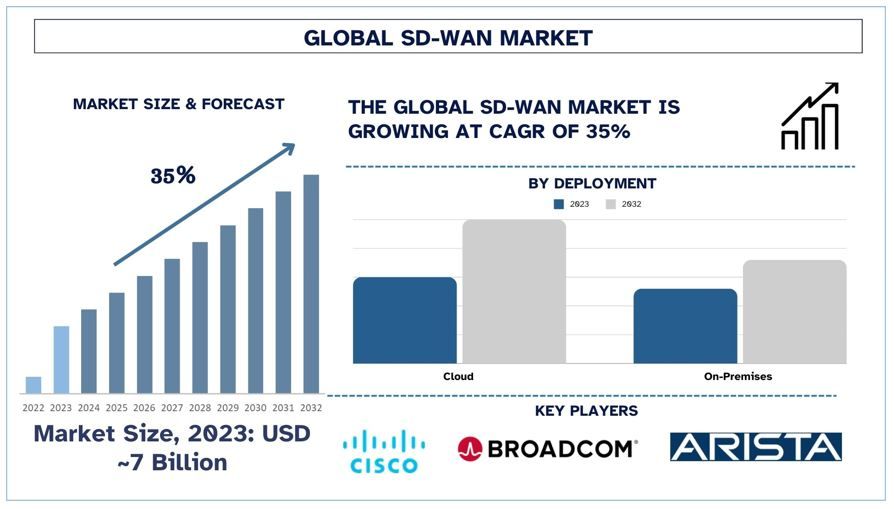 SD-WAN 시장 규모 및 예측
SD-WAN 시장 규모 및 예측
SD-WAN 시장은 2023년에 약 70억 USD로 평가되었으며 클라우드 및 분산 컴퓨팅의 빠른 채택으로 인해 예측 기간(2024-2032) 동안 약 35%의 상당한 CAGR로 성장할 것으로 예상됩니다.
SD-WAN 시장 분석
SD-WAN은 WAN 연결을 관리하기 위해 소프트웨어 정의 광역 네트워크 경로 및 기능을 제공하는 네트워크 기술입니다. MPLS, 광대역, LTE를 포함한 여러 종류의 연결을 수용하여 조직이 가장 편리하고 효과적이며 저렴한 방법으로 올바른 선택을 할 수 있도록 합니다. 또한 SD-WAN은 암호화 서비스 및 방화벽과 같은 고급 보안 요소로 구성되어 전달되는 정보의 안전을 보장합니다.
이 부문은 네트워크 솔루션 관리에서 AI 및 머신 러닝과 같은 새로운 기능 향상을 통해 SD-WAN 기술의 지속적인 혁신과 트래픽 흐름에 대한 더 나은 분석 예측을 제공합니다. 2024년 2월, Broadcom Inc.에 인수된 VMware는 통신 서비스 제공업체(CSP)가 네트워크를 현대화하고 새로운 수익성 있는 서비스를 창출할 수 있도록 지원하기 위해 5G, SD-WAN, SASE 및 Edge Compute(총칭하여 Software-Defined Edge 포트폴리오) 전반에 걸쳐 중요한 새로운 개발 사항을 발표했습니다.
SD-WAN 시장 동향
이 섹션에서는 연구 전문가가 확인한 SD-WAN 시장의 다양한 부문에 영향을 미치는 주요 시장 동향에 대해 설명합니다.
SD-WAN 산업을 변화시키는 클라우드
클라우드 부문은 클라우드 트래픽 관리를 위한 더욱 유연하고 확장 가능하며 효율적인 솔루션의 사용을 개선하면서 SD-WAN 시장에 대한 수요를 창출합니다. 더 많은 애플리케이션과 서비스가 클라우드로 이동함에 따라 SD-WAN은 온프레미스 위치에서 이러한 클라우드를 효율적으로 연결하는 데 필요한 적절한 수준의 민첩성과 성능 향상을 추가하는 데 필요한 도구입니다. 이 통합은 조직이 새로운 고유한 또는 다중 클라우드 환경의 증가하는 복잡성을 처리하는 데 도움이 되므로 SD-WAN은 클라우드 운영 운영을 개선하고 전체 네트워크의 성능 용량을 늘리는 데 중요합니다. 예를 들어, 2021년 3월 30일 Cisco는 새롭고 확장된 Secure Access Service Edge(SASE) 제안을 출시했습니다. 이는 네트워크 운영(NetOps) 및 보안 운영(SecOps) 팀이 사용자를 애플리케이션에 안전하게 연결할 수 있도록 지원하여 보안 및 네트워킹을 근본적으로 단순화하려는 Cisco 여정의 다음 중요한 단계입니다. 또한 Cisco는 클라우드 네이티브 플랫폼인 SecureX를 개선하여 새롭고 떠오르는 위협을 더 빠르고 효과적으로 관리할 수 있도록 했습니다.
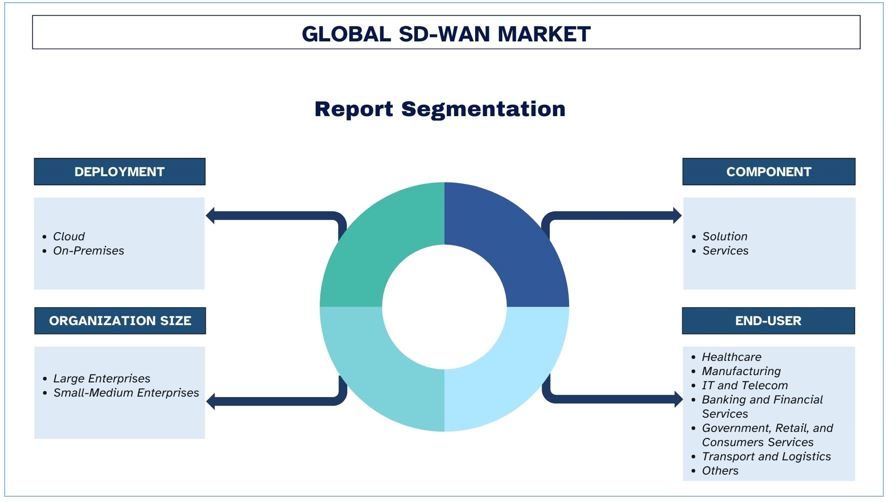
북미가 2023년 시장을 선도합니다.
북미는 네트워크의 기술 개발, 클라우드 서비스에 대한 관심 증가, 디지털화 프로세스에 대한 집중으로 인해 2023년에 시장 점유율이 높았습니다. 북미의 주요 기업 및 조직은 이제 SD-WAN을 사용하여 네트워크 개선, 클라우드 및 하이브리드 네트워크의 복잡성 및 사용량 증가, 비용 관리를 수행합니다. 예를 들어, 2023년 11월 Orange Business와 VMware, Inc.는 Evolution Platform에서 완전히 내장된 최초의 SD-WAN 제품으로 VMware와 함께 유연한 SD-WAN을 제공하기 위해 파트너십을 강화했습니다. Orange Business Evolution Platform은 안전한 디지털 인프라와 민첩한 클라우드 방식을 결합하여 서비스를 주문하고 관리합니다. 북미에서 안정적이고 안전하며 고성능 연결에 대한 필요성은 새로운 작업 방식, SaaS 애플리케이션의 확장, 새로운 네트워크 유연성 및 네트워크 속도에 대한 요구로 잘 설명됩니다. 또한, 5G 발전 및 기타 차세대 네트워킹 서비스에 대한 이 지역의 강력한 집중은 SD-WAN 시장의 성장에 강력한 촉진제를 제공할 것입니다. 또한, 사이버 보안에 대한 우려와 함께 북미의 규정 준수 표준은 보안 기능이 통합된 SD-WAN 솔루션의 구현에 영향을 미쳐 북미의 SD-WAN 솔루션 소비 리더십을 확보했습니다.
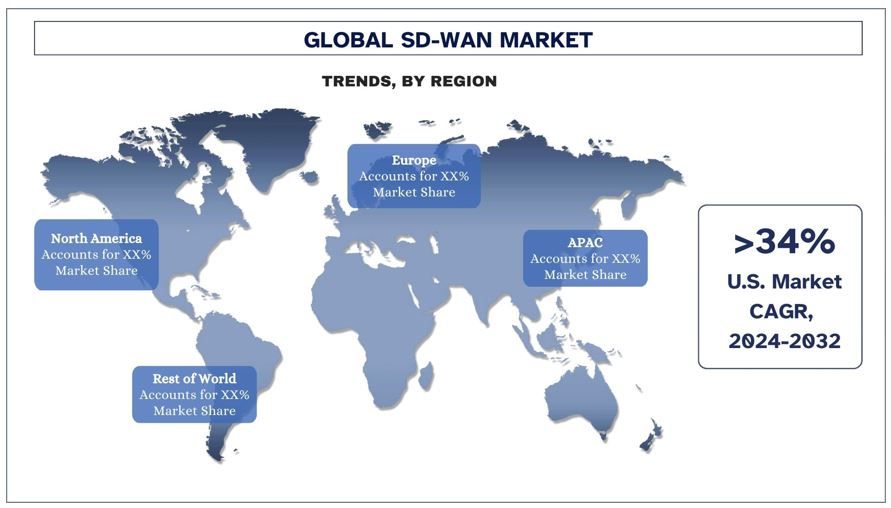
SD-WAN 산업 개요
SD-WAN 시장은 여러 글로벌 및 국제 플레이어와 함께 경쟁이 치열합니다. 주요 플레이어는 파트너십, 계약, 협업, 신제품 출시, 지리적 확장, 인수 합병과 같은 다양한 성장 전략을 채택하여 시장 입지를 강화하고 있습니다. 시장에서 활동하는 주요 플레이어로는 Cisco Systems Inc., Broadcom, Arista Networks, Inc., Fortinet, Inc., Palo Alto Networks., Hewlett Packard Enterprise Development LP, Barracuda Networks, Inc., Cloud Software Group, Inc., Huawei Technologies Co., Ltd., ARYAKA NETWORKS, INC.가 있습니다.
SD-WAN 시장 뉴스
- 2023년 10월 3일 – 세계 최대의 IT 인프라 서비스 제공업체인 Kyndryl은 Palo Alto Networks와 전략적 글로벌 제휴를 맺고 Prisma SD-WAN을 통해 엔터프라이즈 및 Industry 4.0 고객을 위한 새로운 서비스 제공을 포함한 엔드 투 엔드 네트워크 및 사이버 보안 서비스를 제공한다고 발표했습니다.
- 2023년 6월 7일 – Fortinet은 11개의 새로운 MSSP(Managed Security Service Provider)가 고객에게 더 나은 비즈니스 결과와 경험을 제공하는 데 도움이 되도록 Fortinet Secure SD-WAN을 채택했다고 발표했습니다.
- 2023년 3월 22일 – 통합 SASE 솔루션의 선두 주자인 Aryaka는 중소기업(SME)의 요구 사항을 충족하도록 특별히 설계된 향상된 SD-WAN 및 SASE 제품을 발표했습니다. 사이트당 150 USD 미만의 진입 가격으로 Aryaka는 애플리케이션 최적화, 네트워크 보안, 멀티 클라우드 연결 및 클라우드 기반 관찰 가능성 및 제어를 포함한 대안에 비해 보다 포괄적인 관리 서비스 기능 세트를 제공하며, 모든 것이 라이프사이클 서비스 관리에서 지원됩니다.
- 2021년 12월 7일 – Cloud-First WAN 및 보안 회사인 Aryaka는 클라우드 채택을 가속화하고 비즈니스 민첩성을 높이기 위해 여러 엔터프라이즈 부문에 대한 "올인원" SD-WAN 및 보안 액세스 서비스 에지(SASE) 제품을 발표했습니다.
SD-WAN 시장 보고서 범위
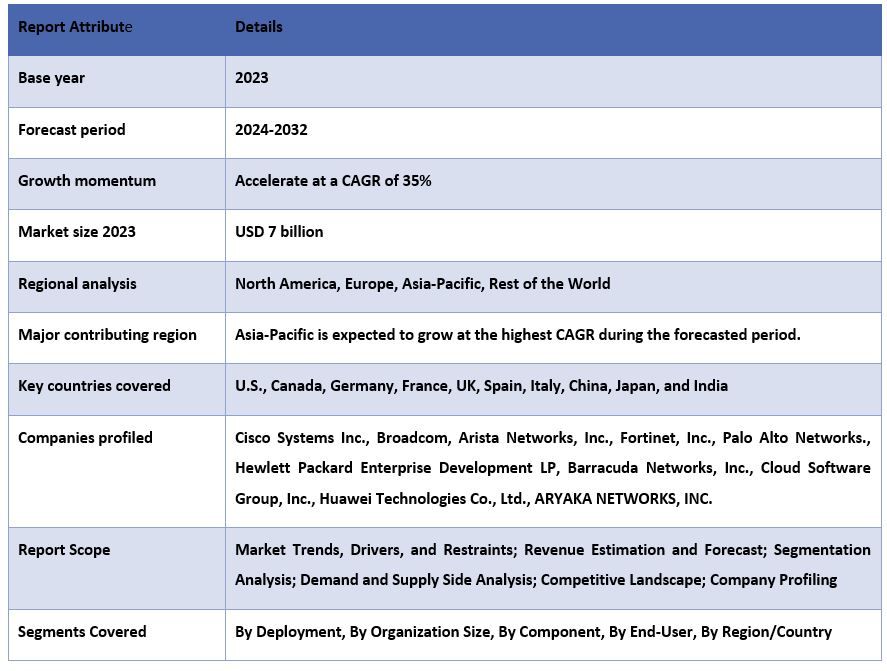
이 보고서를 구매해야 하는 이유:
- 이 연구에는 인증된 주요 산업 전문가가 검증한 시장 규모 및 예측 분석이 포함되어 있습니다.
- 이 보고서는 전체 산업 성과에 대한 빠른 검토를 한눈에 제공합니다.
- 이 보고서는 주요 비즈니스 재무, 제품 포트폴리오, 확장 전략 및 최근 개발에 중점을 두고 주요 산업 동료에 대한 심층 분석을 다룹니다.
- 업계에 만연한 동인, 제약, 주요 동향 및 기회에 대한 자세한 조사.
- 이 연구는 다양한 부문에 걸쳐 시장을 포괄적으로 다룹니다.
- 업계에 대한 심층적인 지역 수준 분석.
맞춤화 옵션:
글로벌 SD-WAN 시장은 요구 사항 또는 기타 시장 부문에 따라 추가로 맞춤화할 수 있습니다. 이 외에도 UMI는 귀하가 고유한 비즈니스 요구 사항을 가지고 있음을 이해하므로 귀하의 요구 사항에 완전히 적합한 보고서를 얻으려면 주저하지 말고 당사에 문의하십시오.
목차
SD-WAN 시장 분석 (2024-2032)을 위한 연구 방법론
글로벌 SD-WAN 시장의 과거 시장 분석, 현재 시장 추정 및 미래 시장 예측은 전 세계 주요 지역에서 SD-WAN 도입을 분석하고 평가하기 위해 수행된 세 가지 주요 단계였습니다. 과거 시장 수치를 수집하고 현재 시장 규모를 추정하기 위해 철저한 2차 연구가 수행되었습니다. 둘째, 이러한 통찰력을 검증하기 위해 수많은 결과 및 가정이 고려되었습니다. 또한 전 세계 SD-WAN 시장의 가치 사슬 전반에 걸쳐 업계 전문가들과 광범위한 1차 인터뷰도 수행되었습니다. 1차 인터뷰를 통해 시장 수치를 가정하고 검증한 후, 전체 시장 규모를 예측하기 위해 상향식/하향식 접근 방식을 사용했습니다. 이후 시장 세분화 및 데이터 삼각 측량 방법을 채택하여 산업의 세그먼트 및 하위 세그먼트의 시장 규모를 추정하고 분석했습니다. 자세한 방법론은 아래에 설명되어 있습니다.
과거 시장 규모 분석
1단계: 2차 소스에 대한 심층 연구:
연례 보고서 및 재무 제표, 성과 발표, 보도 자료 등과 같은 회사 내부 소스와 저널, 뉴스 및 기사, 정부 간행물, 경쟁사 간행물, 부문 보고서, 타사 데이터베이스 및 기타 신뢰할 수있는 간행물을 포함한 외부 소스를 통해 SD-WAN 시장의 과거 시장 규모를 얻기 위해 자세한 2차 연구가 수행되었습니다.
2단계: 시장 세분화:
SD-WAN 시장의 과거 시장 규모를 확보한 후 주요 지역에 대한 다양한 세그먼트 및 하위 세그먼트에 대한 과거 시장 통찰력과 점유율을 수집하기 위해 자세한 2차 분석을 수행했습니다. 주요 세그먼트는 배포, 조직 규모, 구성 요소, 최종 사용자 및 지역으로 보고서에 포함됩니다. 또한 해당 지역에서 테스트 모델의 전체 채택을 평가하기 위해 국가 수준 분석을 수행했습니다.
3단계: 요인 분석:
다양한 세그먼트 및 하위 세그먼트의 과거 시장 규모를 확보한 후 SD-WAN 시장의 현재 시장 규모를 추정하기 위해 자세한 요인 분석을 수행했습니다. 또한 SD-WAN 시장의 배포, 조직 규모, 구성 요소, 최종 사용자 및 지역과 같은 종속 변수와 독립 변수를 사용하여 요인 분석을 수행했습니다. 전 세계 SD-WAN 시장 부문에서 최고의 파트너십, 인수 합병, 사업 확장 및 제품 출시를 고려하여 수요 및 공급 측면 시나리오에 대한 철저한 분석이 수행되었습니다.
현재 시장 규모 추정 및 예측
현재 시장 규모 측정: 위 3단계의 실행 가능한 통찰력을 기반으로 현재 시장 규모, 글로벌 SD-WAN 시장의 주요 업체 및 세그먼트의 시장 점유율에 도달했습니다. 필요한 모든 백분율 점유율 분할 및 시장 분석은 위에서 언급한 2차 접근 방식을 사용하여 결정되었으며 1차 인터뷰를 통해 확인되었습니다.
추정 및 예측: 시장 추정 및 예측을 위해 이해 관계자가 사용할 수있는 동인 및 추세, 제약 및 기회를 포함한 다양한 요인에 가중치가 할당되었습니다. 이러한 요소를 분석 한 후 관련 예측 기술, 즉 상향식/하향식 접근 방식을 적용하여 전 세계 주요 시장에서 다양한 세그먼트 및 하위 세그먼트에 대한 2032년 시장 예측에 도달했습니다. 시장 규모를 추정하기 위해 채택된 연구 방법론은 다음과 같습니다.
- 수익 (USD) 측면에서 산업의 시장 규모와 주요 시장 전반에 걸쳐 SD-WAN 시장의 국내 채택률
- 시장 세그먼트 및 하위 세그먼트의 모든 백분율 점유율, 분할 및 분석
- 제공되는 제품 측면에서 글로벌 SD-WAN 시장의 주요 업체. 또한 빠르게 성장하는 시장에서 경쟁하기 위해 이러한 업체가 채택한 성장 전략
시장 규모 및 점유율 검증
1차 연구: 주요 지역의 최고 경영진 (CXO/VP, 영업 책임자, 마케팅 책임자, 운영 책임자, 지역 책임자, 국가 책임자 등)을 포함한 주요 오피니언 리더 (KOL)와 심층 인터뷰를 진행했습니다. 그런 다음 1차 연구 결과를 요약하고 통계 분석을 수행하여 명시된 가설을 입증했습니다. 1차 연구의 입력은 2차 결과와 통합되어 정보를 실행 가능한 통찰력으로 전환했습니다.
다양한 지역의 주요 참가자 분할
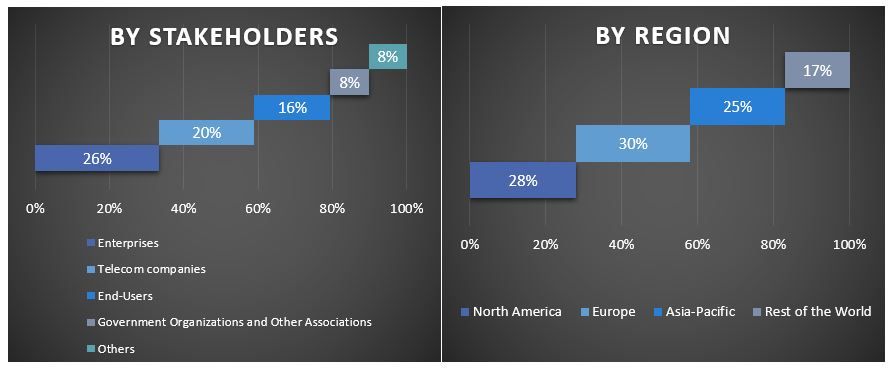
시장 엔지니어링
전체 시장 추정을 완료하고 글로벌 SD-WAN 시장의 각 세그먼트 및 하위 세그먼트에 대한 정확한 통계 수치를 얻기 위해 데이터 삼각 측량 기술을 사용했습니다. 글로벌 SD-WAN 시장의 배포, 조직 규모, 구성 요소, 최종 사용자 및 지역의 다양한 매개 변수 및 추세를 연구 한 후 데이터를 여러 세그먼트 및 하위 세그먼트로 분할했습니다.
글로벌 SD-WAN 시장 조사의 주요 목표
글로벌 SD-WAN 시장의 현재 및 미래 시장 동향이 연구에서 정확히 지적되었습니다. 투자자는 연구에서 수행된 질적 및 양적 분석에 대한 투자 재량권을 기반으로 전략적 통찰력을 얻을 수 있습니다. 현재 및 미래 시장 동향은 지역 수준에서 시장의 전반적인 매력을 결정하여 산업 참가자가 미개척 시장을 활용하여 선점자 이점을 누릴 수있는 플랫폼을 제공했습니다. 연구의 다른 정량적 목표는 다음과 같습니다.
- 가치 (USD) 측면에서 SD-WAN 시장의 현재 및 예측 시장 규모를 분석합니다. 또한 다양한 세그먼트 및 하위 세그먼트의 현재 및 예측 시장 규모를 분석합니다.
- 연구의 세그먼트에는 배포, 조직 규모, 구성 요소, 최종 사용자 및 지역 영역이 포함됩니다.
- SD-WAN에 대한 규제 프레임워크를 정의하고 분석합니다.
- 다양한 중개인의 존재와 관련된 가치 사슬을 분석하고 업계의 고객 및 경쟁업체 행동을 분석합니다.
- 주요 지역에 대한 SD-WAN 시장의 현재 및 예측 시장 규모를 분석합니다.
- 보고서에서 연구된 지역의 주요 국가에는 아시아 태평양, 유럽, 북미 및 기타 지역이 포함됩니다.
- 거리 청소기 시장의 회사 프로필과 빠르게 성장하는 시장을 유지하기 위해 시장 참가자가 채택한 성장 전략.
- 업계에 대한 심층적인 지역 수준 분석
자주 묻는 질문 자주 묻는 질문
Q1: SD-WAN 시장의 현재 규모와 성장 잠재력은 무엇입니까?
Q2: SD-WAN 시장 성장의 주요 동인은 무엇입니까?
Q3: 어떤 부문이 SD-WAN 시장에서 구축 방식으로 가장 큰 점유율을 차지합니까?
Q4: SD-WAN 시장의 주요 트렌드는 무엇입니까?
Q5: 어느 지역이 SD-WAN 시장을 지배할 것인가?
관련 보고서
이 상품을 구매한 고객님들도 함께 구매하신 상품










